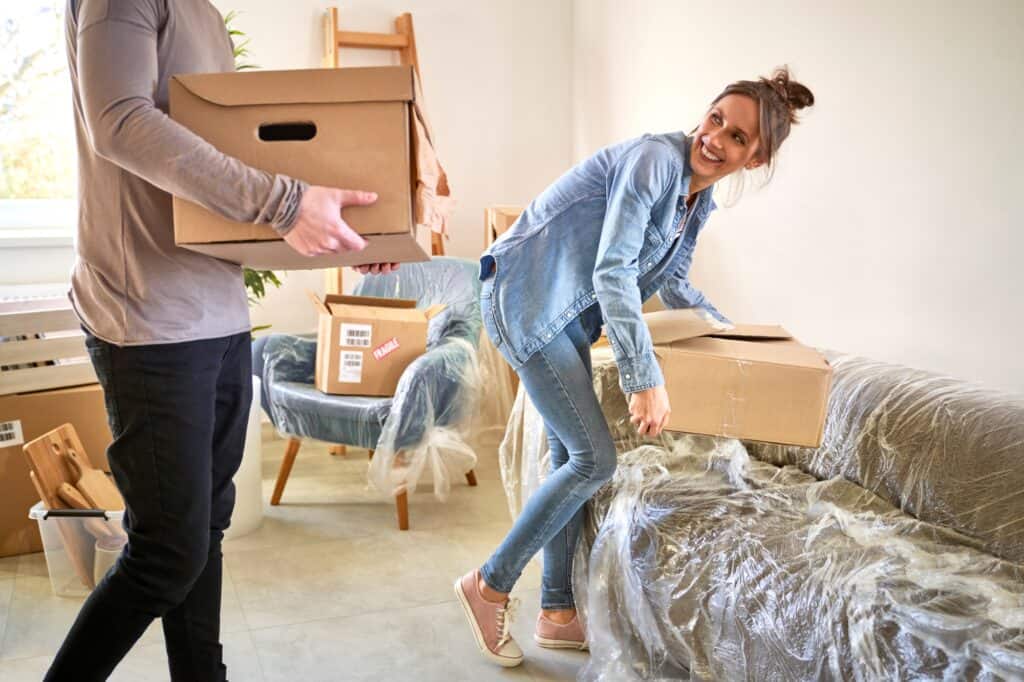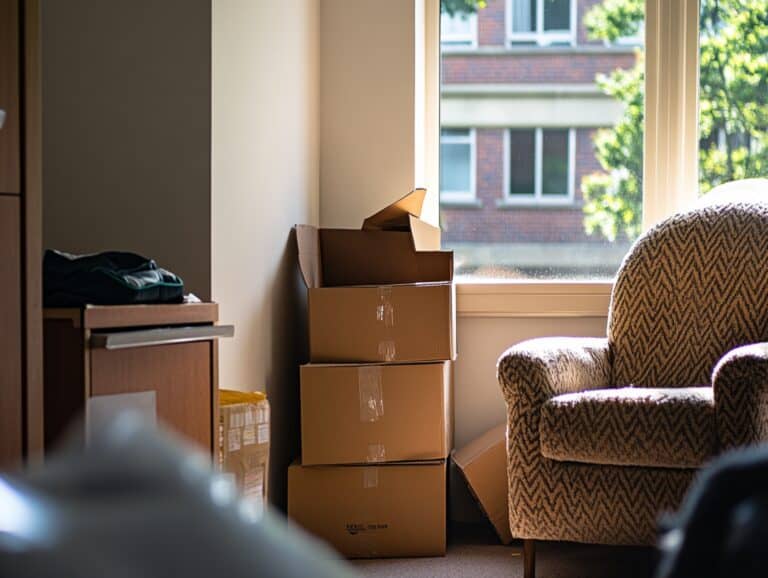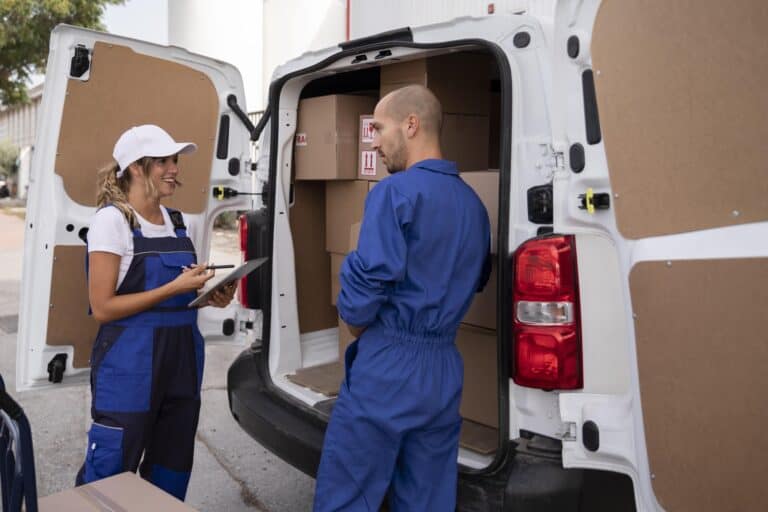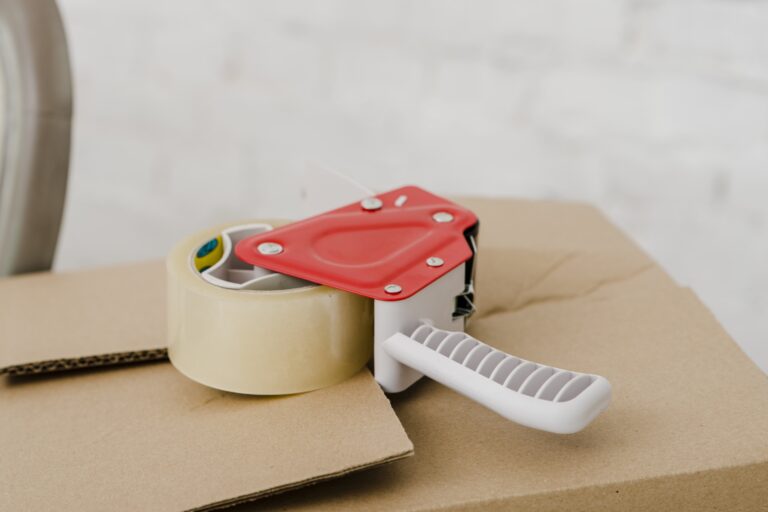Worried about your belongings during a move? Learn how to pack household items safely for a move with our comprehensive guide. Moving can be a daunting task, but with the right packing tips and techniques, you can ensure your possessions are well-protected. From decluttering your home to packing fragile items with care, we cover everything you need to know. Our expert advice will help you navigate the packing process efficiently, making your move smoother and stress-free.
Key Takeaways
- Declutter before packing to reduce moving costs and simplify the process by focusing on frequently used items, ensuring that you only transport what truly matters to your new home.
- Use high-quality packing materials and a room-by-room strategy for organised, efficient packing and easier unpacking, allowing you to settle into your new space without unnecessary stress or confusion.
- Label all boxes clearly and prepare an essentials box to streamline access to necessary items during the move, making it easier to find what you need immediately upon arrival and ensuring a smoother transition.
Make Packing Easier
Start by decluttering your home, which saves time and reduces moving costs by minimising the number of items to pack and transport. Consider how frequently you use each item to decide what to keep or remove. Items unused for over a year should likely go. Begin with the least used rooms to allow a thorough process without requiring immediate access to those items.
Once you’ve decided what to keep, consider donating, selling, or hiring a house-clearance company for the unwanted items. Platforms like Facebook Marketplace and Gumtree are great for selling items you no longer need. You can also sell at a car boot sale or donate to charity shops, ensuring your items find a new home while reducing your moving load.
Streamline the packing process by decluttering and organising your belongings, making it easier to settle into your new home. The fewer items you have, the less you need to pack and move, simplifying your moving house day.
Gather Essential Packing Supplies
Gather all essential supplies before packing, such as high-quality cardboard boxes, packing tape, bubble wrap, old newspapers, and a marker pen. Strong packing boxes are crucial for the safety of your belongings. A few days before the move, collect additional supplies like box cutters, permanent markers, and garbage bags.
Obtain free packing materials from supermarkets, community groups, and local shops. Online marketplaces also offer free or discounted supplies. If reusing old boxes, make sure they are clean, sturdy, and capable of holding your items.
Having the right packing materials is essential for packing efficiently and securely, ensuring that each item is well-protected during the move. By using high-quality materials like sturdy cardboard boxes, bubble wrap, and packing tape, you can significantly reduce the risk of damage to your possessions, making your moving process smoother and more stress-free.
Room-by-Room Packing
Using a room-by-room packing strategy helps maintain order and reduces confusion. Packing one room at a time allows for easier placement of boxes in your new home and helps track items more efficiently. This method also minimises unpacking time, as you’ll know where each box belongs.
Creating an inventory list of packed items can enhance organisation and reduce stress throughout the moving process. Clear labelling aids both you and the moving team in staying organised during the relocation. Write a brief description of the contents of each box to manage mixed items effectively and keep related items together.
Place heavier items at the bottom of mixed-weight boxes for better support and to prevent damage. Avoid overfilling boxes to ensure they stack properly in the moving vehicle. These tips will help ensure a smooth and organised move.

Packing Fragile Items
Take extra care when packing fragile items to ensure they arrive intact. Use sturdy boxes, packing paper, and bubble wrap to secure delicate items. Wrap delicate items individually and separate them with protective layers. Bedsheets and towels can also offer additional protection.
Wrap each dish in paper, bundle them together, and pack them on their sides in dish-barrel boxes. Use bubble wrap for glasses, placing the widest part facing down, and label the box as ‘fragile’.
Filling empty spaces in boxes with soft items like clothing or towels will minimise movement and protect your breakable items. Always label boxes containing fragile items clearly to ensure careful handling during the move.
Wrap Large Furniture
Properly wrapping large furniture prevents damage during transit. Use blankets and plastic wrap for sofas, and tightly cover wooden furniture in blankets to avoid chipping or scratching. Adding cardboard to furniture corners helps minimise damage.
Don’t forget to use dust sheets, old blankets, or stretch wrap when wrapping mattresses for protection. Ensure all items are fully covered to prevent scratches and other damage during the move. By taking these precautions, you’ll ensure your large furniture arrives at your new home in perfect condition.
Disassemble Furniture
Disassemble furniture to save space and prevent damage during transit. Label all parts, including screws, and store them in a sandwich bag taped to the corresponding furniture. Protect the floor from scratches when dismantling.
If dismantling furniture seems complicated, consider hiring removals professionals. They have the expertise and tools needed to safely and efficiently disassemble and reassemble your furniture, ensuring it arrives intact at your new home.
Packing Electronics Safely
To prevent damage, pack electronics safely. Use double-boxing with padding for TVs, and consider wooden crates for plasma TVs. If the original box isn’t available, wrap electronics securely in heavy-duty boxes. Empty and drain electrical items, clean them, and tape doors shut before packing.
Photograph connections before unplugging wires from electronics to assist with reconnection. Remove batteries from devices and store them in resealable bags to prevent leaks. Keep cables and remote controls organised in a separate bag to avoid loss. By following these packing tips, you’ll ensure your electronics are safe and ready to use in your new home.
Use Small Boxes for Heavy Items
Use small boxes for heavy items to prevent damage and ease carrying. Books and kitchen appliances should be packed in small boxes to avoid overloading, which makes them difficult to carry and increases the risk of breaking. Packing heavy items in small boxes also prevents them from damaging other items during the move. This method of packing boxes in a separate box makes the moving process safer and more efficient.
Label Everything Clearly
Labelling helps track and organise items during the move. Include the room, a brief list of contents, and any special handling requirements. Keeping related items together simplifies unpacking and maintains order. Use permanent markers and masking tape to ensure labels are clear and easy to read. This combination makes it simple to identify each box’s contents and destination, facilitating a smoother unpacking process.

Packing Your Essentials
An essentials box is a lifesaver on a moving day. Include toiletries, chargers, clothing, snacks, and drinks for immediate access. A dish towel and all-purpose cleaner will help set up your kitchen quickly. Pack an emergency first aid kit for unforeseen situations.
Keep important documents like new address info, rental or purchase papers, and moving contracts in a folder for easy access. The night before the move, keep a change of clothes, toothbrush, medications, and stuffed toys nearby.
An essentials box should be kept in the car during the move to ensure immediate access upon arrival. This will allow you to quickly retrieve necessary items, such as toiletries and important documents, without having to search through multiple boxes after reaching your new home.
Special Care for Valuables
Pack valuable items with special care. Start well in advance to handle them properly. Use new or specialised boxes for enhanced protection. Wrap pictures with paper or bubble wrap and place cardboard between framed pieces.
Keep jewellery in separate compartments to avoid scratches and tangling. Use a roll-up travel bag designed for secure jewellery transport. Apply blue painter’s tape in a cross pattern on the glass of framed art to secure it during the move. By taking these precautions, you’ll ensure your valuables arrive safely at your new home.
Moving Plants
Moving plants requires special care. Discuss with your removal company beforehand, as some may not transport plants due to their fragility. Ensure pots are intact; damaged pots can harm plants during the move. Pack plants in boxes with air holes to ensure adequate ventilation. Clean plants with a damp cloth upon arrival to remove dust accumulated during transport.
Use Professional Packing Services
Professional packing services can alleviate stress and save time. Full packing services offer professional packaging and extra protection for special items. Partial packing services can include packing special or fragile items.
Antique or delicate furniture may require professional assistance to avoid damage during disassembly. Partial packing services allow you to pack most items yourself while getting help for fragile items. Using professional packing services ensures a smoother and more efficient moving process.
Summary
In summary, successful packing for a move to Lewisham involves careful planning and organisation. From decluttering to using professional packing services, each step is crucial in ensuring a smooth transition to your new home. By following these tips, you’ll make your move to Lewisham a breeze. Embrace the change and enjoy the excitement of your new adventure!
Frequently Asked Questions
What should I do with items I no longer need before moving?
It is advisable to donate, sell, or hire a house-clearance company to manage unwanted items before your move. This approach not only declutters your space but also benefits others.
How can I get free packing materials?
You can acquire free packing materials by reaching out to supermarkets, local shops, and community groups. Additionally, check online marketplaces for available free or discounted supplies.
Why is it important to label boxes clearly?
It is important to label boxes clearly as it facilitates easy identification of contents and destinations, thereby enhancing tracking during the move and streamlining the unpacking process.
What should I include in an essentials box?
An essentials box should contain toiletries, chargers, clothing, snacks, drinks, important documents, and a first aid kit to ensure you are well-prepared after your move. This approach allows for immediate access to necessary items during a transitional period.
How can professional packing services help during a move?
Professional packing services can significantly reduce stress and save time during a move by providing expert packing and added protection for your belongings, leading to a smoother transition.







